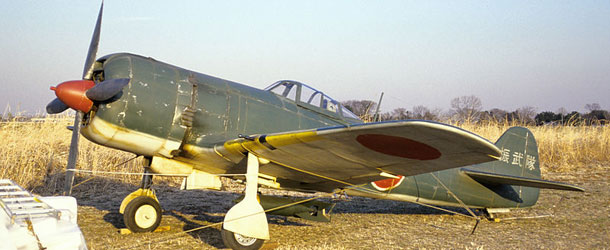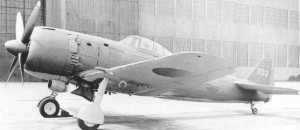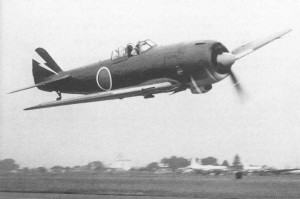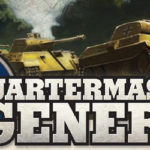The Nakajima Ki-84 “Hayate” (Gale) was a fast, very maneuverable, and well armed Japanese fighter which served the Japanese Army Air Force (JAAF) during the last year of the Pacific War. Nicknamed “Frank” by the Allies, the Ki-84 is considered the best fighter of JAAF in the WW2, with a performance on par with the most advanced Allied fighters and a firepower able to take down the B-29 Superfortresses.
Even if the Ki-84 only entered operation in 1944, the design work started in early 1942. Three weeks after Pearl Harbour, the JAAF instructed Nakajima Hikoki K.K. (Nakajima Aeroplane Co Ltd) to begin design of a replacement for the Ki-43. Requirements were for a general-purpose long-range fighter combining the maneuverability of the Ki-43 with the speed and climb of the Ki-44 Shoki, plus armor protection for the pilot. It was also to be fitted with self-sealing fuel tanks.
The design was completed in mid 1943. The aircraft was a low-wing monoplane with an all-metal airframe, except for the fabric-covered control surfaces. The fuselage section was oval, with flush-riveted, stressed skin. The two-spar wing carried metal-framed, fabric-covered ailerons and was provided with hydraulically-operated Fowler flaps. The tailplane was set well ahead of the vertical surfaces. The cockpit had a bubble canopy that provided the pilot with excellent visibility.
The aircraft was powered with a 1800-hp Nakajima Ha-45 engine, and a big exhaust collector pipe was mounted on each side of the engine behind the cowling gills. A total of 220 US gallons of fuel was carried in tanks aft of the cockpit and in the wings. It was armed with two 12.7 mm Ho-103 machine guns mounted in the upper cowling, and a 20-mm Ho-5 cannon in each wing outboard of the main undercarriage leg. The pilot was protected by a 70-mm armored windshield and by 13-mm armor plate in the rear and floor of the cockpit.
The Ki-84 prototype first flew from Ojima Airfield in April 1943, and the second in June. After trials at the Tachikawa Air Arsenal, recommended modifications were incorporated into the fourth prototype. It had a maximum speed of 394 mph at 21,800 feet and could achieve a speed of 496 mph in a dive. A service trials batch of 83 machines was ordered in August of 1943, and built between August of 1943 and March of 1944. These pre-production machines differed from each other in minor details. Fuselage changes were incorporated to ease production and the area of the fin and rudder was increased to improve control on takeoff.
Production started at Nakajima's Ota plant, in April 1944, followed by the Otsonomiya plant. By December 1944, there were 373 Ki-84s produced, which was the highest one month production of any Japanese army fighter. The fighter was also produced by Mansyu and in 17 months the two manufacturers had delivered 3,382 Ki-84s. Even though the design was solid, the shortage of fuel and construction materials, poor production quality, and a lack of skilled pilots prevented the fighter from reaching its potential.
Early production machines was powered with the Ha-45 engine models 11 and 12, with takeoff ratings of 1800 hp and 1825 hp respectively. Later models used the model 21, delivering 1990 hp for takeoff. These engines were rather unreliable, suffering sudden loss of fuel pressure. To address the problem, in later production, the JAAF adopted the Army Type 4 radial Model 23 (Ha-45-23), a modification of the Model 21 fitted with a low-pressure fuel injection system.
This variant, Ki-84-Ia, was the most widely produced. Other variants include Ki-84-Ib, armed with 4 × 20 mm Ho-5 cannon, and Ki-84-Ic, a specialized bomber destroyer version armed with two 20-mm Ho-5 cannon in the fuselage and two wing-mounted 30-mm Ho-105 cannon. Total production of the Hayate by all factories was 3514, including prototypes and service trials aircraft. The performance and reliability of production Hayates wasn’t as good as that of the service test machines. As the quality of the workmanship steadily deteriorated, the performance of the Hayate steadily declined, with later machines having successively poorer and poorer performance and mechanical reliability.
The Ki-84 came into service in Summer 1944. The experimental squadron conducting service test trials had been disbanded in March, and its personnel transferred to the 22nd Sentai. In August, this unit was re-equipped with production Hayates and transferred to China, where it fought against the P-47 Thunderbolts and P-51 Mustangs of the USAAF's 14th Air Force. In five weeks, the 22nd achieved remarkable results, partly because of its excellent new aircraft and partly because it contained many of the best Japanese pilots.
The Hayates had their first major combat test during the battle of Leyte, in October 1944. The 22nd Sentai was moved to the Philippines, where it was joined by the 1st, 11th, 21st, 51st, 52nd, 55th, 200th, and 246th Sentais. After a promising start, the Ha-45 engine proved itself to be rather unreliable, as did the landing gear, and the number of serviceable aircraft dropped rapidly. Many of the replacement aircraft were either lost en-route from Japan or had a much poorer performance than expected. The fighter was on par with the best Allied counterparts when flown by an experienced pilot, but the Japanese were increasingly outnumbered.
Despite that, until the end of the Pacific war the Ki-84 were deployed wherever the action was intense. The Hayates were used for long-range penetration missions, fighter sweeps, strafing, interception, and dive-bombing missions with considerable success. It was also capable of inflicting serious damage on the B-29s, at least until they moved from daylight operations to night bombing.
In the battle for Okinawa (early April to mid June 1945), the Ki-84s were used by the 101st, 102nd, and 103rd Hiko Sentais, and two new Sentais, the 111th and the 200th were activated with them. They operated in a hit-and-run capacity from southern Kyushu. Once again the Japanese fighters were overwhelmed by Allied numbers, especially after the Allies began to attack the bases in Kyushu.
Information sources: Military Factory, WWII Vehicles, Century of Flight, History of War, Wikipedia.
Top image: Nakajima Ki-84 (Army Type 4 Fighter) by contri, from Yonezawa-Shi, Yamagata, Japan.











Follow Us on